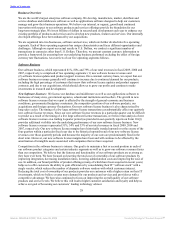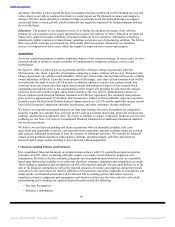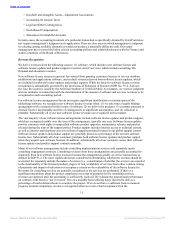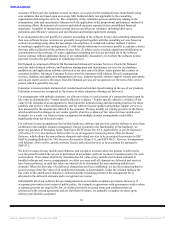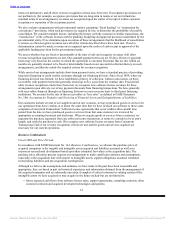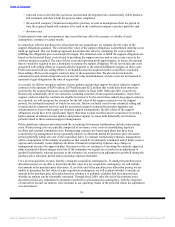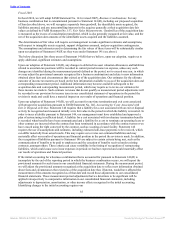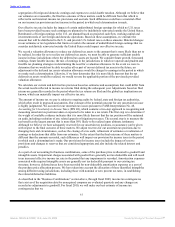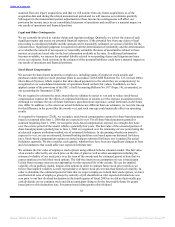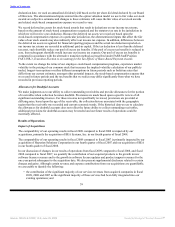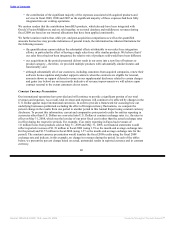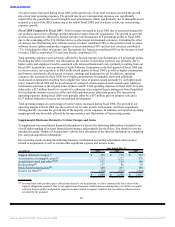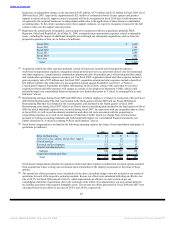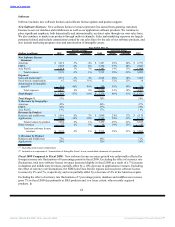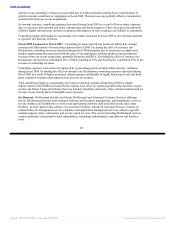Oracle 2008 Annual Report Download - page 43
Download and view the complete annual report
Please find page 43 of the 2008 Oracle annual report below. You can navigate through the pages in the report by either clicking on the pages listed below, or by using the keyword search tool below to find specific information within the annual report.
Table of Contents
assumed from our legacy acquisitions, and that we will assume from any future acquisitions, as of the
acquisition date and during the related measurement period and we will reassess our estimates quarterly.
Subsequent to the measurement period, adjustments to these income tax contingencies will affect our
provision for income taxes in our consolidated statement of operations and could have a material impact on
our results of operations and financial position.
Legal and Other Contingencies
We are currently involved in various claims and legal proceedings. Quarterly, we review the status of each
significant matter and assess our potential financial exposure. If the potential loss from any claim or legal
proceeding is considered probable and the amount can be reasonably estimated, we accrue a liability for the
estimated loss. Significant judgment is required in both the determination of probability and the determination
as to whether the amount of an exposure is reasonably estimable. Because of uncertainties related to these
matters, accruals are based only on the best information available at the time. As additional information
becomes available, we reassess the potential liability related to our pending claims and litigation and may
revise our estimates. Such revisions in the estimates of the potential liabilities could have a material impact on
our results of operations and financial position.
Stock-Based Compensation
We account for share-based payments to employees, including grants of employee stock awards and
purchases under employee stock purchase plans in accordance with FASB Statement No. 123 (revised 2004),
Share-Based Payment, which requires that share-based payments (to the extent they are compensatory) be
recognized in our consolidated statements of operations based on their fair values. In addition, we have
applied certain of the provisions of the SEC’s Staff Accounting Bulletin No. 107 (Topic 14), as amended, in
our accounting for Statement 123(R).
We are required to estimate the stock awards that we ultimately expect to vest and to reduce stock-based
compensation expense for the effects of estimated forfeitures of awards over the expense recognition period.
Although we estimate the rate of future forfeitures upon historical experience, actual forfeitures in the future
may differ. In addition, to the extent our actual forfeitures are different than our estimates, we record a true-up
for the difference in the period that the awards vest, and such true-ups could materially affect our operating
results.
As required by Statement 123(R), we recognize stock-based compensation expense for share-based payments
issued or assumed after June 1, 2006 that are expected to vest. For all share-based payments granted or
assumed beginning June 1, 2006, we recognize stock-based compensation expense on a straight-line basis
over the service period of the award, which is generally four years. The fair value of the unvested portion of
share-based payments granted prior to June 1, 2006 is recognized over the remaining service period using the
accelerated expense attribution method, net of estimated forfeitures. In determining whether an award is
expected to vest, we use an estimated, forward-looking forfeiture rate based upon our historical forfeiture
rates. Stock-based compensation expense recorded using an estimated forfeiture rate is updated for actual
forfeitures quarterly. We also consider, each quarter, whether there have been any significant changes in facts
and circumstances that would affect our expected forfeiture rate.
We estimate the fair value of employee stock options using a Black-Scholes valuation model. The fair value
of an award is affected by our stock price on the date of grant as well as other assumptions including the
estimated volatility of our stock price over the term of the awards and the estimated period of time that we
expect employees to hold their stock options. The risk-free interest rate assumption we use is based upon
United States treasury interest rates appropriate for the expected life of the awards. We use the implied
volatility of our publicly traded, longest-term options in order to estimate future stock price trends as we
believe that implied volatility is more representative of future stock price trends than historical volatility. In
order to determine the estimated period of time that we expect employees to hold their stock options, we have
used historical rates of employee groups by seniority of job classification. Our expected dividend rate was
zero prior to our first dividend declaration in the fourth quarter of fiscal 2009 as we did not historically pay
cash dividends on our common stock and did not anticipate doing so for the foreseeable future for grants
issued prior to this declaration date. For grants issued subsequent to this dividend
38
Source: ORACLE CORP, 10-K, June 29, 2009 Powered by Morningstar® Document Research℠


